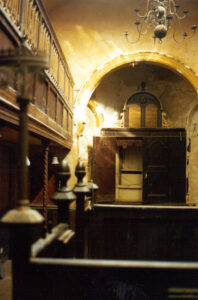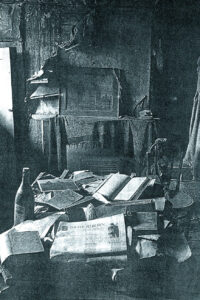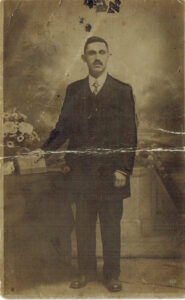Welcome To Our Special Correspondent
My name is Dr Rachel Lichtenstein, I’m a British artist, writer and academic whose publications, multi-media projects and artworks examine themes of place, memory, and Jewish identity. The connecting thread between all this work is rigorous historical research, which means I spend a lot of time in archives – they are my favourite places! I am delighted therefore to have been asked by the Rothschild Foundation Hanadiv Europe to be their special correspondent for the relaunch of the Hidden Treasures website. Over the next year I will be reporting here on the ‘collection encounters’ I have with various British archives that feature on this site. I will be taking a deep dive behind the scenes, to meet with archivists, conservators, and curators as they share the hidden treasures held in their collections, that relate to the long, rich, and varied history of Jewish culture and life in Britain. I can’t wait!
As a way of introduction let me tell you a little about myself and my ongoing fascination with archives. My father and grandfather were both antique dealers, which meant I spent a lot of time as a child at antique fairs and auction houses, looking at fascinating old things. I started collecting when I was about ten years old using my pocket money to purchase items like vintage postcards, used stamps, Victorian photographs, and antique buttons. These artefacts had little monetary value, but I was captivated by them. My favourite childhood game was to hold these things in my hands then try and guess the stories behind them. I have been trying to reconstruct the historical past from the fragments that are left behind ever since.
My early artistic work focused on my Polish Jewish heritage. By the age of eighteen I was taking research trips to Poland, visiting archives such as the Jewish Historical Institute in Warsaw, as well as local libraries and museums around the country. On my return I used elements of the material I had gathered there, alongside items from my grandfather’s east London watchmaking shop, to make multimedia artworks about these research journeys.

Princelet Shul
After I completed a degree in Fine Art Sculpture, I became the unpaid artist-in-residence at the Princelet Street Synagogue just off Brick Lane, which was hoping at that time to become a museum of immigration. I came across a remarkable story there, connected to an unexplored archive in that building. In an attic room above the synagogue were boxes filled with possessions belonging to an orthodox Jewish scholar called David Rodinsky who had lived in that room then mysteriously disappeared in the 1960s. When Rodinsky’s abandoned room was unlocked for the first time in 1980, it looked as if it had been frozen in time, with everything in its original state, even down to porridge on the stove and the imprint of a head on a pillow. Tucked inside books scattered around the room were notes written in ancient scripts including Aramaic, Hebrew and even Egyptian Hieroglyphics. Dictionaries of multiple languages, handwritten notebooks, records and other ephemera lay stacked in towers upon the floor waiting beneath a layer of dust.
 After many years of research, my first book Rodinsky’s Room (written in collaboration with Iain Sinclair, Granta, 1999) tracks my journey to uncover Rodinsky’s story, mainly through a deep examination of the material he left behind. Soon after this book was published, I was invited to become the British Library’s first ever Creative Research Fellow due to my imaginative approach to using archives, and the multidisciplinary nature of my work. I spent eighteen months exploring the manuscript collections there, resulting in the publication of A Little Dust Whispered (British Library, 2002), which highlights unusual details from their holdings, such as the fingerprint of a monk left in the margin of a medieval manuscript, a poem written on the back of an envelope, and a single leaf inserted within a handwritten diary smuggled out of a Russian prison.
After many years of research, my first book Rodinsky’s Room (written in collaboration with Iain Sinclair, Granta, 1999) tracks my journey to uncover Rodinsky’s story, mainly through a deep examination of the material he left behind. Soon after this book was published, I was invited to become the British Library’s first ever Creative Research Fellow due to my imaginative approach to using archives, and the multidisciplinary nature of my work. I spent eighteen months exploring the manuscript collections there, resulting in the publication of A Little Dust Whispered (British Library, 2002), which highlights unusual details from their holdings, such as the fingerprint of a monk left in the margin of a medieval manuscript, a poem written on the back of an envelope, and a single leaf inserted within a handwritten diary smuggled out of a Russian prison.
Since this time, thanks to mentors such as the late East London historian Professor Bill Fishman I have become a tour guide of the former Jewish East End, as well as an oral historian. I have collected hundreds of hours of recorded testimony over the years, mainly of memories that focus on the London experience. Some of these collections are held in public institutions others appear in my other publications including On Brick Lane (Penguin, 2007), Diamond Street (Penguin, 2012) and Estuary (Penguin, 2016) which all involved years of research in multiple archives.
 Before becoming a full-time academic, I worked as an archivist and historian at London’s oldest still functioning Ashkenazi synagogue, Sandys Row in Spitalfields. This involved conducting oral histories with the remaining community and depositing original material from the synagogue into the Bishopsgate Institute Archives. This philanthropic institution was established in the Victorian era to provide educational facilities and a library for the poor of East London and now holds a large collection of material relating to the many different communities who have lived in the area, including the Jewish community. The transfer process was undertaken with the help of volunteers working in collaboration with Chief Archivist Stefan Dickers and his team. The many documents and artefacts in this wonderful collection include nineteenth century marriage certificates, Torah scroll mantles made from women’s dresses and handwritten minute books, the earliest of these were written in Dutch. A digital copy of this material is available on the project website Our Hidden Histories, which features as one of the archives on the Hidden Treasures website.
Before becoming a full-time academic, I worked as an archivist and historian at London’s oldest still functioning Ashkenazi synagogue, Sandys Row in Spitalfields. This involved conducting oral histories with the remaining community and depositing original material from the synagogue into the Bishopsgate Institute Archives. This philanthropic institution was established in the Victorian era to provide educational facilities and a library for the poor of East London and now holds a large collection of material relating to the many different communities who have lived in the area, including the Jewish community. The transfer process was undertaken with the help of volunteers working in collaboration with Chief Archivist Stefan Dickers and his team. The many documents and artefacts in this wonderful collection include nineteenth century marriage certificates, Torah scroll mantles made from women’s dresses and handwritten minute books, the earliest of these were written in Dutch. A digital copy of this material is available on the project website Our Hidden Histories, which features as one of the archives on the Hidden Treasures website.
Another digital project I produced in collaborative with colleagues at the Survey of London and University College London that also appears on Hidden Treasures is the interactive Memory Map of the Jewish East End . On this digital map you will find excerpts from my substantial archive of oral history recordings with former and current Jewish residents of East London whom I have interviewed over the years, many of whom are sadly no longer with us. Hundreds of archival photographs can also be accessed on the map, along with original research which was collated from research at numerous archival institutions. This was followed by the Memory Map of Jewish Manchester, which features the recordings of Manchester based oral historian Dr Ros Livshin. I am currently working on a book and another digital archive project, that tracks the work and life of the legendary Polish-born Yiddish poet Avram Nachum Stencl (1897-1983). You can hear more about this work here in the radio programme The Poet of Whitechapel that features recordings of people sharing their stories about Stencl and his famous Yiddish literary society The Friends of Yiddish.